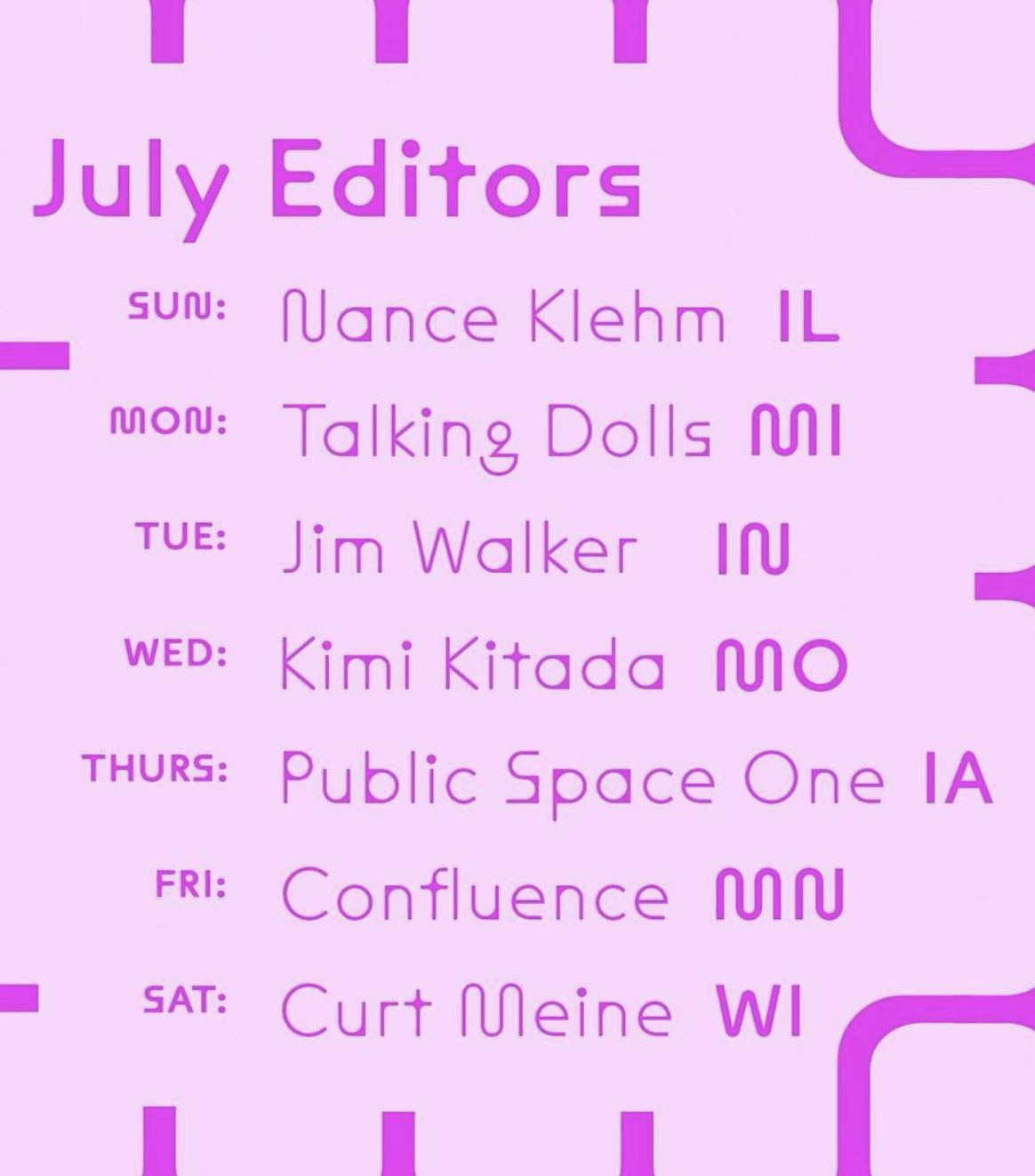

Part alternative archive, part grassroots mapping initiative, MdW Atlas is a daily online publication. Find stories, art, and media everyday here for July and August! We want Atlas to guide you through the wide swath of creative activity across the midwest.


Letter From Detroit
JULY 2022Written By Talking Dolls
Talking Dolls is a collectively, predominantly Black-owned artists' studio that has been in operation on the Eastside of Detroit since 2011. It is currently co-owned and operated by Ron Watters, Andrea Cardinal, and Wesley Taylor.
We are situated in an industrial strip on East Davison Ave comprising independently owned auto repair shops, lumberyards, machine shops, and small-scale factories. We are a block away from Detroit's longest-running vinyl production plant, Archer Records, which has mass-produced LPs and 45s for legendary Detroit labels such as Motown and Underground Resistance for decades. Historically, the businesses in this corridor were mostly owned by the residents of Hamtramck, an adjacent municipality surrounded by Detroit on all sides, which once held one of the largest concentrations of Eastern European immigrants (mostly of Polish descent) in the Midwest. Within a mile radius, we are flanked by several close-knit working-class black neighborhoods, multiple cemeteries, intersecting freight train lines, Detroit Detention Center, and City Airport. A ten minute walk South of our building are large-scale metal processing facilities, and a ten minute walk to the North is the Perfecting Church campus, stewarded by gospel music powerhouse the Winans Family.
As far as we know, there is no name or clear borders that distinguish our neighborhood. Our immediate area registers cold on a heat map for real estate speculators and development interests. There are many factors changing the fabric of our neighborhood, though. There are only a handful of business still owned by the Eastern European community, as Hamtramck has now become the only Muslim-majority city in the US, with growing Bangladeshi and Yemeni-American communities. Four years ago, our strip of East Davison was designated as a “Green Zone” for the sanctioned production of marijuana, and as a result, we have witnessed many of the industrial buildings on our street converted into grow operations. The tell-tale signs that a building will soon become a weed grow is that all of the activity in and around the building ceases. Then the new owners paint the building black, reinforce the windows with cinder blocks, mount cameras on the perimeter, and barricade the building with large concrete blocks and fences.
The boom and bust cycles of the marijuana industry have had the most drastic impact on the landscape in our neighborhood, both visibly and economically. A year ago property values skyrocketed, due to the high demand for small industrial buildings to house startup grow operations. Now the market is in disarray because of the larger industrial operations taking hold in the area and saturating the market with cheaper product, making it untenable for smaller growers. This disarray has led to more For Sale signs on buildings than we’ve ever witnessed before, leading to uncertainty about how this new wave of turnover will transform the surrounding neighborhoods in the near future. It is also important to note that the residents of the neighborhoods don’t benefit economically from the industries on Davison, because those are owned, operated, and staffed by people living outside the city of Detroit. Even though the residents share backyards with these businesses, they do not see a bump in their property values. Despite the proximity, there is very little flow in the form of communication, resources, or services, a disenfranchisement that predated the marijauna boom by decades.
All of this external scene setting of the current conditions of our neighborhood is important to understand how the socio-economic factors that govern space and place have been central to our story as a studio, since Talking Dolls’ inception. We have had two locations, both within a two block radius. In our first location, we established Talking Dolls under the pretense of generating stability for ourselves through forming a tight-knit community, paying cheap rent, and secluding ourselves from the rest of the world. Five of the six of the founding members attended Cranbrook Academy of Art; we valued the spirit of experimentation, collaboration, and interdisciplinary work that the institution instilled in us and desired to keep it going post graduation. We found a place on Craigslist in a building called the Toy Warehouse, a former toy wholesaler that already housed a ragtag assortment of artists collectives and off-the-grid entrepreneurial pursuits in its massive 150,000 square foot footprint. The extremely loud signage wrapping the massive building and advertising the wholesaler’s products in large bold lettering is how we adopted our name and identity. (We also had the choice of “trucks, backpacks, cars, etc.”).
At the Toy Warehouse, we were able to negotiate a deal enabling us to pay $1,500 monthly for a 10,000 s/f ground level chunk of the building. In this space we could incubate our own practices, generate interesting projects, and work independently at scales both temporally and spatially unimaginable in the other urban centers where our peers moved post graduation. This was exemplified by the experimental architectural projects prototyped by founding member and architect Aaron Jones. Another example is the development of Complex Movements’ Beware of the Dandelions, an immersive performance where we merged the disciplines of architecture, design, music, film, animation, performance, technology, complexity science and social movement organizing. In that same space, we housed an extensive wood and metal fabrication shop, as well as a fullscale screenprint studio.
The discipline of screen printing played a major role in our ability to serve the larger Detroit creative community. Over the years, we have been able to collectively pool resources to assemble a robust print shop. Talking Dolls member Ron Watters has been growing his practice of actively mentoring the city’s youth through his screen printing business One Custom City, and as a result, countless clothing labels, spinoff print shops, and grassroots political campaigns in and around Detroit can trace their origins to his expertise and generosity. We also established the Incubator Residency (IR) for Cranbrook students in-between their first and second years of graduate school. We recognized a need for a program like this due to the lack of support the institution provides for students in the summer months. The IR was successful in its initial mission in that it was able to host a wide array of artists and their practices and provide them with the time and space to hone their craft, as well as become oriented with the city in ways they would not normally get to. Past IR participants include Jova Lynne, Conrad Egyir, Victoria Shaheen, and Ebi Baralaye.
One of the biggest challenges we’ve faced also turned out to be one of our biggest blessings. In 2015, we were blindsided when the Toy Warehouse was purchased at the Wayne County Tax auction by West Coast investors hoping to develop the building into an upscale mixed-use shared working retail space. We were not aware of the building's delinquent tax status, as we were still paying rent to our landlord, thinking he was in possession of the building. This caught all of the building's residents off-guard, as none of us were able to make a deal with the new owners. As a result, we were all displaced in January, during one of Michigan’s most brutal winters. Luckily, in the midst of the chaos caused by this upheaval, we were able to secure a place right around the corner. An auto mechanic looking to move his operation was putting the building up for rent or sale. At the time, the building was so full of car parts that we could barely even see or step on the floor in order to inspect it. In our desperation, we decided to take it and have been in the building ever since.
In the new building, we were able to commit more to our mission and develop new strategies. Talking Dolls core membership swelled and then shrank, as some members decided it was time to move on and start new ventures. After two years of occupying the building, the remaining members were able to purchase it. Ownership was a major step in securing our place in the neighborhood, allowing us to dig deeper in our mission, but it also came with its challenges.
We have always been self aware of our privileged position as artists and how that position in any community can have many unintended consequences. When done with intention and support, those consequences can be powerful and positive, but more often than not they can fail miserably, resulting in many negative impacts on unwitting community members. One such consequence is the possibility of triggering a wave of artist gentrifiers, if we were not careful in the way we occupied our place in the community.
In other areas of the city, artists were celebrated for their ability to change a community, and their projects have been given high profile attention in the media. Yet many times, those projects have mixed reviews by those living near them, and often enough, as time passes, the dust from the media hype settles, and funding dries up, there are major voids and messes to be cleaned up by the neighbors. One strategy we adopted to avoid this scenario was to blend in as best as we could. We opted not to have any signage or markers of our location and to leave the facade of the building untouched, maintaining the nondescript aesthetic of the previous owners. This camouflage strategy prevented us from unintentionally signaling to other artists that this was a great place to set up shop, and it also prevented us from being targets. In all the time that we've occupied the building, we’ve never had a security system or cameras, and we have never been vandalized or broken into. However, we have been violated by the police on several occasions. On one occasion, two close friends of the studio (one a 17 year old intern) were held at gunpoint by the police, who mistook our studio for an illegal marijuana grow.
Another challenge of ownership was that it was difficult for the remaining Talking Dolls members to shoulder the financial burden. Our objective has never been to squeeze the artist working in the building for rent. We see that as antithetical to our mission, and we would severely transform the use of the building if we maximized square footage for renters. We have been lucky enough to receive the support of other artists and collectives. One such partnership was with Bulk Space, a collective of interdisciplinary artists and Cranbrook graduates who shared a similar trajectory just a few years later. We were able to nestle their collective inside our collective, as they had just experienced their own displacement. Ultimately, Bulk Space saved us in our time of need. Not only were they critical in helping us pay the mounting bills, but they also brought an influx of energy and fresh ideas. They helped us expand the Incubator Residency by providing programming through arranging studio visits and mentorship for the residents, as well as launching an initiative to exhibit their work. We are forever grateful for our wider community of artists who have come in at crucial times to help us level up and expand our mission.
During the Covid lockdowns, we did our best to keep our doors open in a semi-public way, in order to continue to support the artists in our community. Doing so was exacting, to say the least. We did our best to work with our tenants and partners to devise safety and accountability systems, ensuring access to the building was still possible in useful and equitable ways. We devised a schedule, with staggered shifts of when people could work in the building, to maximize productivity while reducing probability for infections. Like everyone during this time, we had no idea what we were doing, and only hoped that the measures of care and consideration would keep people healthy and safe. We had no idea whether measures like signup sheets tracking people's times in the building were effective, or if people were actually using the disinfectant stations. We hoped the rent reductions and at times, forgiveness would be enough to get people through. Ultimately, it was the combination of loss of employment, uncertainty, and loss of capacity and health due to Covid infections that put a strain on the studio. We were unable to continue unless we made some drastic changes. We were not poised to take advantage of stimulus support, nor did we have institutional support or grants to help with the financial burden. Our biggest loss was having to part ways with Bulk Space. Those experiences forced us to grow as a studio, and we continue to navigate the waves of Covid while synthesizing our collective lessons.
This summer marks the 10-year anniversary of Talking Dolls’ Incubator Residency (IR). To celebrate this milestone, we have decided to ask our current residents to submit work for MDW Atlas. This summer’s cohort represents both emerging and established voices in the Detroit creative community. They include MC/music producer/fashion designer Miz Korona, designer/animator/song writer/art director Evie Dahmer, filmmaker/writer/multimedia artist bree gant, graphic designer Reed Smith, and multimedia artist/photographer/painter Diana Noh. Our contributors have practices rooted in mapping the city through thoughtful investigations, creative interventions, and a compelling variety of media. Their works explore marginalized bodies in urban and suburban space as they encounter public transportation, the commons, and social networks. These explorations are synthesized into song, film, and installation, which residents are currently developing while acclimating to the studio.
Together with residents, this summer we hope to add a hyper-local focus, as we seek to explore our immediate neighborhood’s agency to produce, operate, manage, and maintain collections of print-based artifacts of both intrinsic and extrinsic value. These collections could encompass everything from family reunion shirts and protest banners, to fine art prints and alternative NFTs. This project will build on Talking Dolls’ current methods of studio practice, mentorship, exchange, training, education, pedagogy, cooperative ownership, and archiving.


